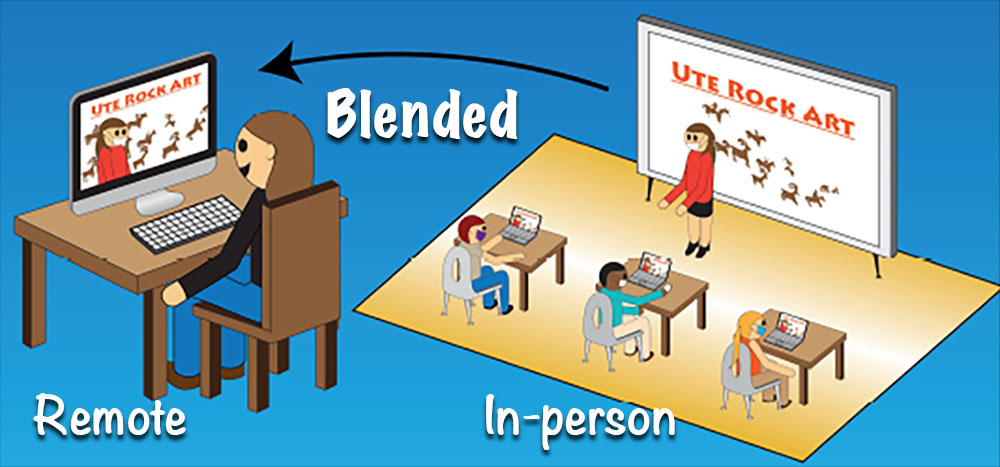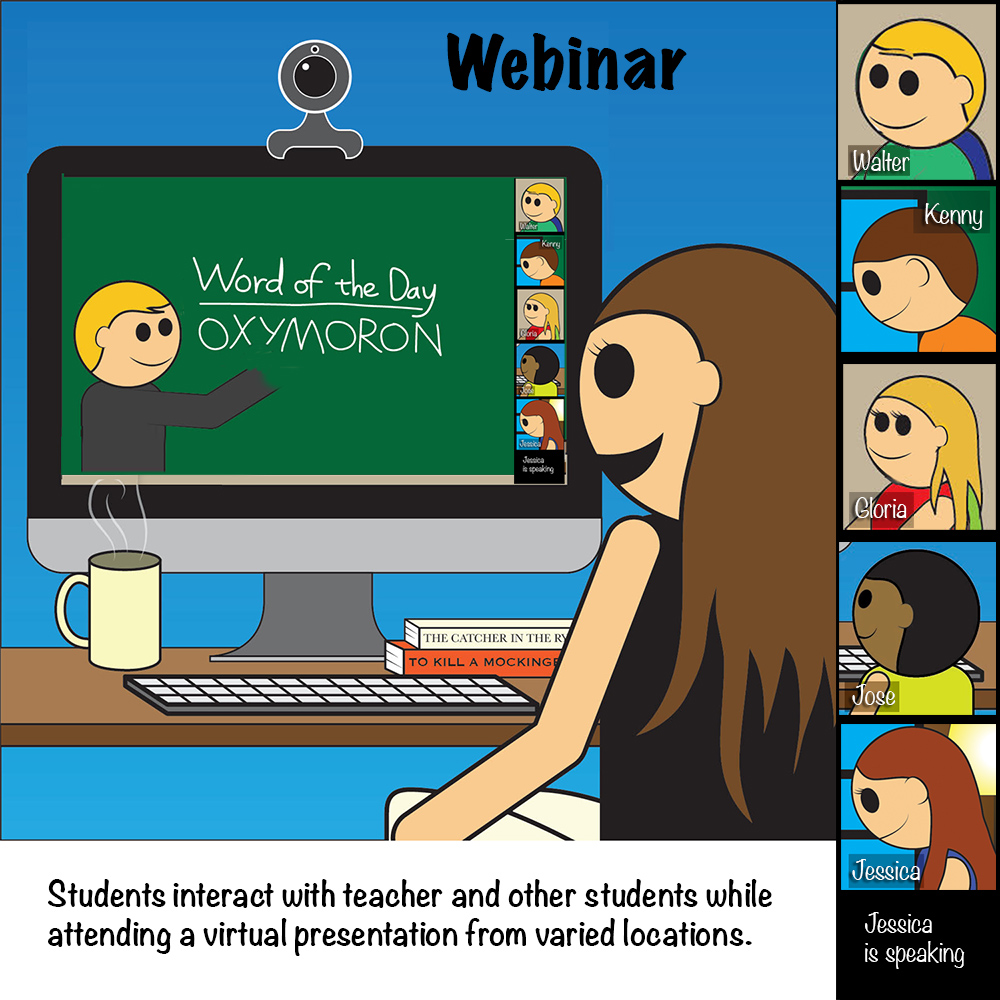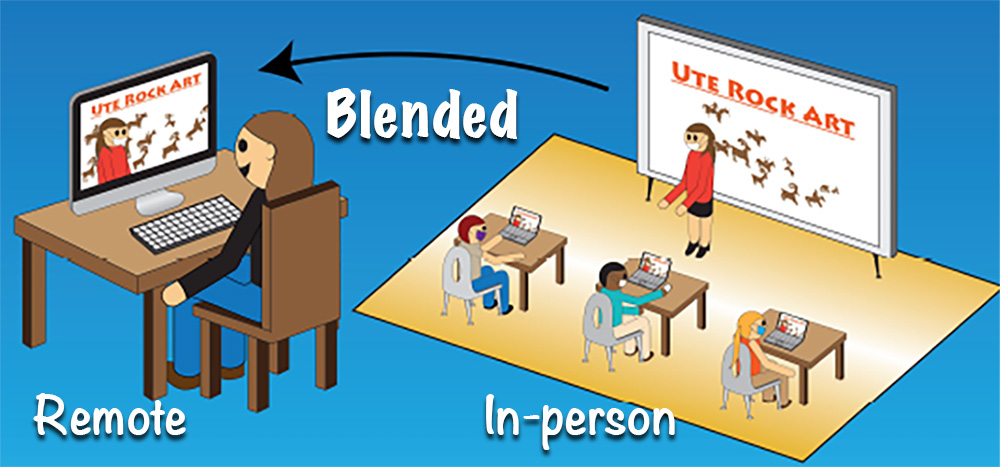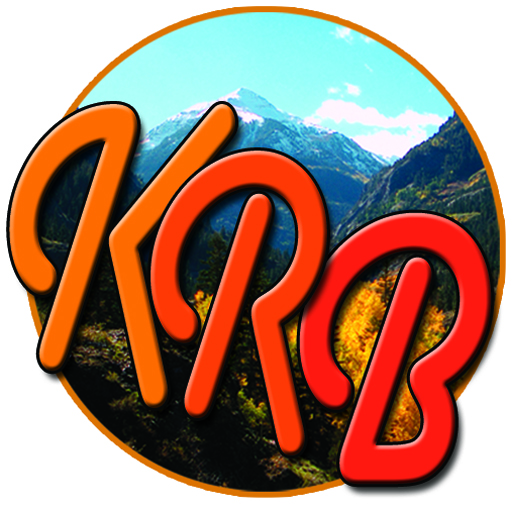
Hybrid Learning. Illustration, Bryce Chismire.
Today’s Education – A Technical Enterprise
[San Juan Silver Stage | September 2020 | Kathryn R. Burke]
Illustrations by Bryce Chismire.
[Author note: This article was written during the height of Covid, when schools, students, teachers, and parents were struggling to figure out how to keep kids educated… and safe. This is one of a series of articles sponsored by Elevate Internet, which provided the most reliable high-speed internet in the Montrose, Colo. area. The company also made affordable Wan and Lan Internet programs available to students and schools.]
According to the CDC (Centers for Disease Control and Prevention), “Schools are an essential part of the infrastructure of communities, as they provide safe, supportive learning environments for students, employ teachers and other staff, and enable parents, guardians, and caregivers to go to work. Schools also provide critical services that help to mitigate health disparities, such as school meal programs, social, physical, behavioral, and mental health services. Communities should make every effort to support the reopening of schools safely for in person learning.”
That all sounds great, but because of Covid, traditional in-person (or classroom) learning has, by necessity, had to adopt a variety of teaching methods and tools to ensure that education continues uninterrupted. This includes virtual (remote or online) learning, in-person learning, where students may be divided into cohorts (or groups), and various hybrid systems (alternating between virtual and in-class learning. But even with an in-person scenario, classrooms often look very different, with students and teachers masked and 3-6’ social distancing protections in place such as screens around students and/or the teacher. Often the teacher is also giving instruction remotely at the same time for students who are unable to attend in person or whose families have opted for strictly remote learning. So class presentations must be designed to facilitate both. For teachers, lesson planning becomes a challenge. For students, the new systems is complicated, but easily absorbable. For parents? Especially if they will have to homeschool? Complicated at the very least. The first step is to master the vocabulary. Next is learning how to implement it.

Traditional, in-person learning
Kids come to class. Every day, same school, same classroom and teacher (elementary grades) or in a mix of classrooms and teachers (middle and high school). Kids eat lunch together, take recess or play sports together. There is still some of this, in some schools, but it has morphed, in most cases, with Covid-preventing measures (social distancing, no touching, masking) and simultaneous teaching methods, since lessons may be broadcast for remote learning at the same time, i.e. kids in class, kids at home, kids in both places.
Virtual Learning Environment (VLE)
Kids don’t come to school; they learn from someplace else. Also known as Online, Distance, or Remote Learning, VLE is an educational technology delivered on a Web-based platform for the digital aspects of courses of study. Resources, activities, and interactions are presented (broadcast to a remote audience. VLEs also usually report on participation; and have some level of integration with other institutional systems. VLEs have been adopted by almost all higher education institutions in the English-speaking world. [Wikipedia]
To be effective and engaging (and avoid a virtual brain dump), VLEs facilitate and encourage a two-way partnership and audience participation. They should also provide context for content to make the information relatable for learners (i.e., telling a story rather than just giving a lecture with PowerPoint slides). The greater variety of learning tools used, especially visuals, the more effective the lesson. One thing to consider, In a 2017 study, it was shown that the brain is not capable of consciously listening and reading at the same time. Learners learn better if they listen instead of reading, so on-screen images with very little text, while the teacher explains them usually work best [e-learning industry]. Kids take lessons at any remote location, via the Internet on a computer, laptop, or hand-held device such as a tablet or smart phone.

Webinar
Also known as web conferencing, this is a VLE tool. Webinars employ online collaborative services utilizing software invoked by all participants. Everybody tunes in at once… or later if it’s been taped. Webinars Include audio conferencing, and some allow for use of a “webcam” to include video as well. Services may allow real-time point-to-point communications as multicast communications from one sender to many receivers. It offers data streams of text-based messages, voice and video chat to be shared simultaneously, across geographically dispersed locations. Depending on the technology being used, participants may speak and listen to audio over standard telephone lines or via computer microphones and speakers. Students watch a presentation via the Internet on a digital device and may or may not choose to interact visually with other participants. Presentations can be taped for listening later. Perfect for a bad hair day or going to class in your pajamas.
Video Conferencing
Beefed up Webinar that allows users in different locations to hold face-to-face meetings, attend a concert or “live” show, or participate in presentations remotely from a web-connected computer to other web-connected computers. It includes videotelephony and online chat services through a cloud-based peer-to-peer software platform and is used for teleconferencing, telecommuting, entertainment, distance education, and social relations. You can attend a class or concert without actually being there. Collaboration without congregation.
Numerous platforms are available including Google Hangouts and Adobe Connect, but Zoom is the leader in modern enterprise video communications, especially educational presentations, with an easy, reliable cloud platform for video and audio conferencing, chat, and webinars. Same as an audio webinar, but you can be seen by and interact with the other participants. Get dressed before you tune in.
Numerous platforms are available including Google Hangouts and Adobe Connect, but Zoom is the leader in modern enterprise video communications, especially educational presentations, with an easy, reliable cloud platform for video and audio conferencing, chat, and webinars. Same as an audio webinar, but you can be seen by and interact with the other participants. Get dressed before you tune in.
Cohort (in education)
What used to be called a “pod”—a group of students, and sometimes teachers or staff, that stay together throughout the school day to minimize exposure for students, teachers, and staff across the school environment. During the time of Covid, ideally, students and staff within a cohort would only have physical proximity with others in the same cohort, thus: limiting transmission of the virus; facilitating contract tracing, and; allowing for targeted testing, quarantine, and isolation of a single cohort instead of school-wide measures in the event of a positive case or cluster of cases. Cohorting can be done as part of a traditional model with all students attending school in-person, on a full-time basis, or as part of a of a hybrid school model (i.e., students attending in-person school on an alternating schedule). Cohorting is a commonly used strategy in many elementary schools, in which students have the same teacher and classmates during the entire day and often for the entire school year. For students participating in hybrid learning (mix of in-person and virtual classes), cohorts are rotating groups of students attending in-person classes. [CDC FAQ for School Administrators on Reopening Schools.] Kids learn and hang out together in a common group.

Hybrid learning
This is pretty much where all the schools are today. It’s a combination of in-person (classroom) and online (virtual via Internet broadcast) learning, the latter either Simultaneously: teacher teaching in class and broadcasting lesson to remote students at the same time, or: Alternating: students alternate between physically attending class and completing lessons by computer at home.
Simultaneous. Because this teaching scenario involves students in the classroom and students attending remotely, a key consideration is how to ensure that all students can hear the instructor and participate in any discussion. In many cases, Zoom (or a similar video-conferencing system) works because it can be used to present to and interact with students simultaneously in the classroom and online. It allows instructors to share their screen, show slides, use break-out rooms, and chat with in-person and remote students. In discussion-based classes, in-person students can log in to Zoom using their laptops or phones so that remote students can see them. [Cornell University. “In-person teaching with remote students.]
Alternating. This allows educational institutions to limit the number of students in the classroom or facility at any one time. It is more often used in middle or high school, where kids are more likely to congregate outside of their assigned cohorts, so the administration sets up a schedule to keep them separated as much as possible. Elementary kids, whom it is thought are less likely to get or spread Covid, usually fare better with in-person classroom instruction, so most of their classes are in-person.
What Are Local Schools Doing?
Similar but different, all three county districts—Ouray, Montrose, Delta—agree on keeping elementary kids in class if possible and limiting student socialization and interaction at the high school level. When it comes to middle-schoolers, there is more diversity. All three districts offer an online-learning option and are prepared to transition to totally online if it becomes necessary.
MCSD Montrose County School District.
6,154 students, 14 public schools.
The Montrose and Olathe Schools “Return to Learn” program offers a choice between five different models. (1) 100% Remote Learning. Students learn remotely and will not participate in athletics or extra-curricular activities, (2) Online Learning. Students spend the majority of time learning remotely but may attend in-person for tutoring, hands-on courses, extra-curricular activities and athletics. (3) Hybrid/Temporary Remote/In-person. Students attend school in person unless schools need to transition to remote for a temporary period of time due to a Covid outbreak. (4) In-person Learning. Students attend school in person and are grouped into manageable cohorts to allow for more efficient contact tracing if needed. (5) Traditional Students attend school as previoulsy organized in a traditional school setting. Minor mitigation strategies may remain as needed. [MCSD Return to Learn]
DCSD Delta County School District (includes Delta and Cedaredge).
5,058 students. 18 public schools.
The Delta School System Restart Plan. (Delta, Cedaredge) includes in-person learning, five days a week, for elementary and middle school students. Elementary students may eat lunch in the cafeteria and go outside during recess times. Middle school students will remain in a grade-level cohort as much as possible during the day. Students may have a modified block schedule which means they may have fewer classes for longer time periods each day. High-schoolers will alternate in-person and remote learning on a daily basis to limit the number of students in the building. For students of any grade who unable to attend In-person learning, Online learning is provided daily instruction through Colorado Digital Learning Solutions. Families will only be able to switch between In-Person learning and the Online Learning program at the semester break. [DCSD Restart Plan]
Ouray County – two school districts, three schools, total 540 students.
Ridgway School District. 360 students.
Elementary and Secondary School.Back to School Plan 2020
Elementary and Secondary School.Back to School Plan 2020
The Ridgway School District utilizes a blended learning approach incorporating an online learning platform, protective health measures and the use of outdoor learning venues, providing flexibility should large infection spikes in the year force suspension of in-person learning. The Elementary School will utilize a staggared start and pick-up schedule throughout the school year. The Secondary School will observe a standard start and pick-up times. No early release schedule will be implemented with the exception of parent-teacher conference days. RSD has partnered with Colorado Digital Learning Solutions (CDLS) to offer a full online program for students that do not want to return to school in person.
Ouray School District. 180 students. 1 school.
Ouray schools offer choice between fully online or in-person learning. Unlike some plans implemented in larger districts, there is no blended learning options, in which students attend classes online some days and in-person on other days. Students who choose the online option will enroll in classes offered by Colorado Digital Learning Solutions and won’t be taught by Ouray teachers, but will still be considered Ouray students. Students won’t be able to change between in-person or remote classes mid-semester but could choose to switch at mid-year.
What’s Age Got to Do With it?
New information (or at least new of this writing) suggests younger children are less likely to cause COVID-19 spread. In guidance released recently, the Colorado Department of Education said “global COVID-19 evidence suggests that younger children play a smaller role in onward transmission of COVID-19,” and the risk of young children passing the virus to each other or to adults is lower than older children and adults. While the goal is to maintain in-person classes as much as possible, a split-school model could be used if necessary to reduce the number of people in the building, with only middle and high school students moving to remote learning.
Online Learning Programs for Local Schools
If a student is not able to attend In-Person learning, they may enroll in their school’s Online Learning Program for the 2020-2021. Students that enroll in their school’s 2020-2021 Online Learning Program will receive 100% of their instruction off site. Students will be provided daily instruction through Colorado Digital Learning Solutions). Families will only be able to switch between In-Person learning and the Online Learning program at the semester break.
Colorado Digital Learning Solutions – Online Learning Platform
Colorado Digital Learning Solutions (CDLS) to offer a full online program for students that do not want to return to school in person. To explore the CDLS course offerings and to view full course syllabi, please visit:
- Colorado Digital Learning Solutions: Elementary Programming
• Colorado Digital Learning Solutions: Middle School / High School Programming
The Bottom Line
All the plans for all the local schools are still flexible, as schools or individual classrooms, may have to transition to Distance Learning during this school year if confronted with a Covid outbreak. Which, unfortunately, is more likely than not to happen. Traditionally, kids all get sick when school starts. Colds, flu, lots of bugs floating around as kids cough, sneeze, and share germs with each other, their teachers, and their families. This year will be the same but different. Is it Covid? Or is it a cold? Testing and Contact Tracing will help, but kids will be kids, and it’s inevitible that there will be Covid Confusion as families and school administrators make tough decisions about what is best for the children.


